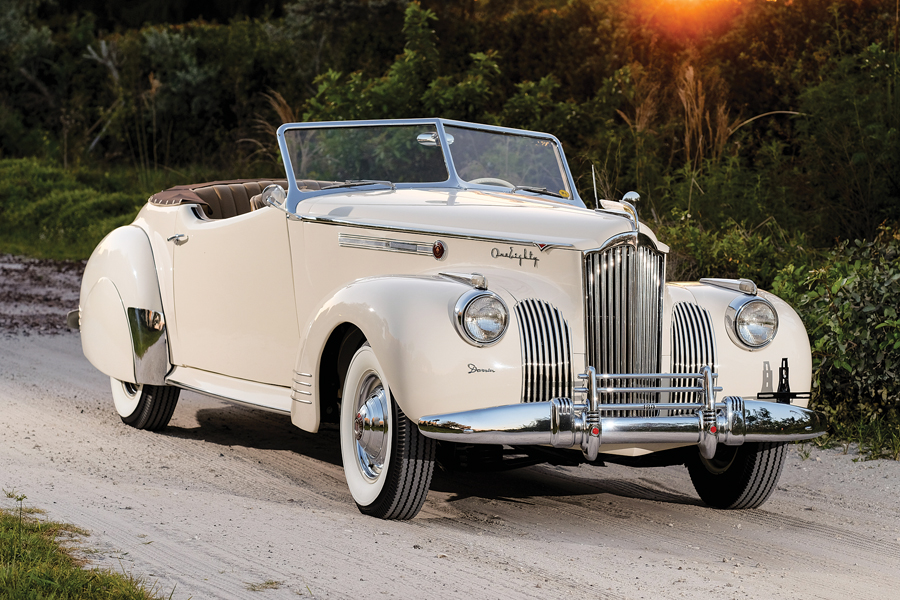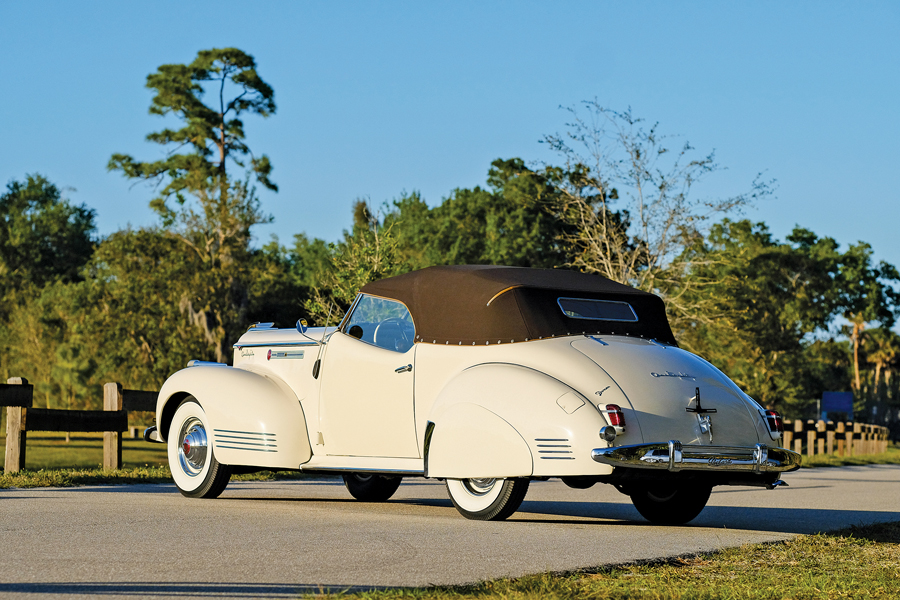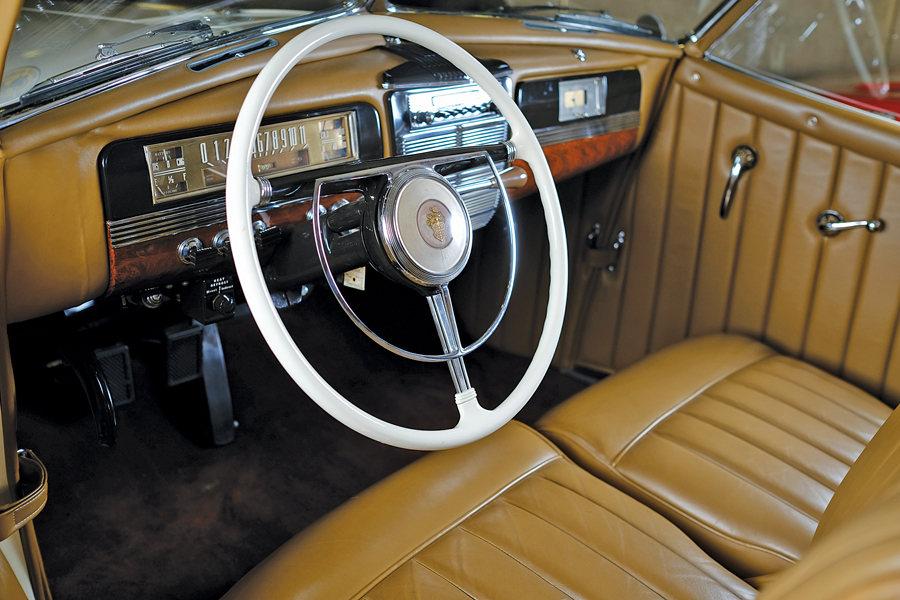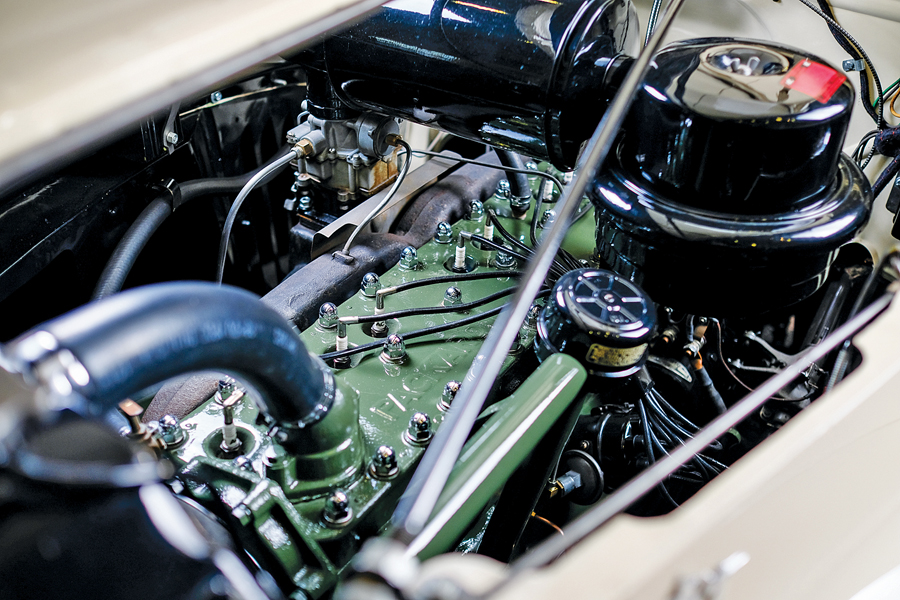The Packard Darrin was a special automobile in the maker’s lineup. It was a blending of all the glory that was Packard in the Classic Era and the stunning design work of Howard “Dutch” Darrin. The result was one of the more glamorous cars of the 1940s.
According to its body tag, this Darrin was first delivered to Mead Motor Co. in Houston, TX, on June 27, 1941. It has since been restored by Stone Barn Restoration from what is described as a solid, original car. Included are the jack, spare wheel, convertible top boot and storage bag. A former AACA and CCCA National Prize Winner, the car presents beautifully, finished in Cream over saddle leather with a dark chocolate canvas top and period-appropriate wide whitewall tires. Fender skirts complete the sleek and svelte look that can only be Darrin. Optional equipment includes radio, clock, heater/defroster, grille guard and back-up lamp. It is equally nice under the hood as it is on the exterior. The consignor describes the car to be in “excellent driving condition,” and as a CCCA Full Classic, it is ready to show and tour.
SCM Analysis
Detailing
| Vehicle: | 1941 Packard One-Eighty Convertible Victoria by Darrin |
| Years Produced: | 1941 |
| Number Produced: | 35 |
| Original List Price: | $4,795 |
| SCM Valuation: | $266,750 |
| Tune Up Cost: | $250 |
| Distributor Caps: | $100 |
| Chassis Number Location: | Plate on firewall |
| Engine Number Location: | Boss under left side of cylinder block |
| Club Info: | Packard’s International Motor Car Club |
| Website: | http://www.packardsinternational.com |
| Alternatives: | 1941 Packard Bohman and Schwartz Convertible Victoria, 1929–32 Packard Deluxe Eight Convertible, 1933–36 Packard Twelve open |
| Investment Grade: | B |
This car, Lot 3112, sold for $360,000, including buyer’s premium, at Auctions America’s Auburn Spring sale in Auburn, IN, on May 13, 2017.
Howard “Dutch” Darrin was a most interesting man. We, of course, are aware of his striking coachwork that originated in Europe and Hollywood.
He was also an accomplished polo player. Darrin also claimed he caught the note that Charles Lindbergh dropped from the “Spirit of St. Louis” when he circled the Eiffel Tower after his historic transatlantic flight.
Off to Paris
In the early 1920s, Darrin and his friend Tom Hibbard went to Paris with the idea of establishing a European branch of Le Baron.
They organized their firm as Hibbard and Darrin. Their firm was, of course, successful, with most of their custom coachwork sold to Americans living in Europe. Hibbard soon tired of custom coachwork and left to work for Harley Earl at General Motors in 1931.
With a modern manufacturing facility and a prestigious showroom on the Champs-Élysées, Darrin joined with a wealthy banker named J. Fernandez and continued creating dramatic coachwork for American clients.
One of their best-known creations was a 1933 Duesenberg for screen goddess Greta Garbo.
Cars for the stars
Darrin met movie mogul Darryl Zanuck at the Paris Polo Club and was invited to play in California. Darrin had such a wonderful time that he decided to return to America in 1937. The declining coachbuilt market in Europe was also a factor in his decision.
Darrin built a sporty body on a Ford for Percy Morgan, a restaurateur and Morgan importer. Their first Packard was a 120 convertible for actor Dick Powell, with cut-down “Darrin Dip” doors and lengthened hood. Powell sold the car shortly thereafter as it caused a commotion whenever he drove it.
Darrin subsequently opened a shop on Sunset Strip in Los Angeles, and called it “Darrin of Paris.”
Darrin built about 22 custom Packards in 1938 and 1939 for Hollywood stars, including Errol Flynn, Al Jolson and Carole Lombard, who gave her car to Clark Gable.
A major concern was, however, a very unstable front end that vibrated at speed. Darrin removed the heavy cradle under the radiator to lower the car. He replaced the cradle with a thin strap, so there was no real strength to the front fenders. The change also caused a door-alignment problem.
Darrin wanted Packard to include his cars in their catalog as semi-custom offerings, but they showed little interest. He parked one of his cars outside the Packard Proving Grounds during a dealer meeting, and the reaction was overwhelming.
When Packard President Alvan Macauley asked Darrin about the strength of the front end, Darrin climbed onto the car and jumped up and down on the cowl, asking, “Is that strong enough?”
Packard relented and included three Darrin models in the 1940 catalog — and insisted that they be built on the Super Eight chassis.
Darrin’s factory
At first the cars were built in an old Auburn factory in Connersville, IN. In 1941, Packard moved his operation to the Sayers and Scovill plant that also built the Packard Henney hearse. Packard exerted influence over the manufacturing and design, which improved the structural integrity of the cars.
As such, the 1941–42 Packard Darrins are the most desirable cars. It is thought that 35 Darrin convertibles were constructed on the Super Eight chassis. Another 15 were built in 1942 before World War II halted production.
A great Packard Darrin at a huge price
Stone Barn restored — to high standards — our subject 1941 Packard Darrin One-Eighty. The car has AACA and CCCA National First awards to its credit. Options included heater/defroster, grille guard and fender skirts. It also was equipped with a radio and back-up light.
RM Sotheby’s, at their January 2012 Arizona auction, sold a 1941 Darrin One-Eighty Convertible Victoria that appeared to be in very comparable condition for $225,500. It was chassis number 2013, the next build after our subject car.
Packard Darrins have been coming into their own of late, but it’s difficult to justify a 37% appreciation in five short years. As such, I’ll say that RM’s Darrin was well bought in 2012. The new owner of out subject car paid an aggressive price for an appreciating Darrin, but he may have bought a bit too early. ♦
(Introductory description courtesy of Auctions America.)



